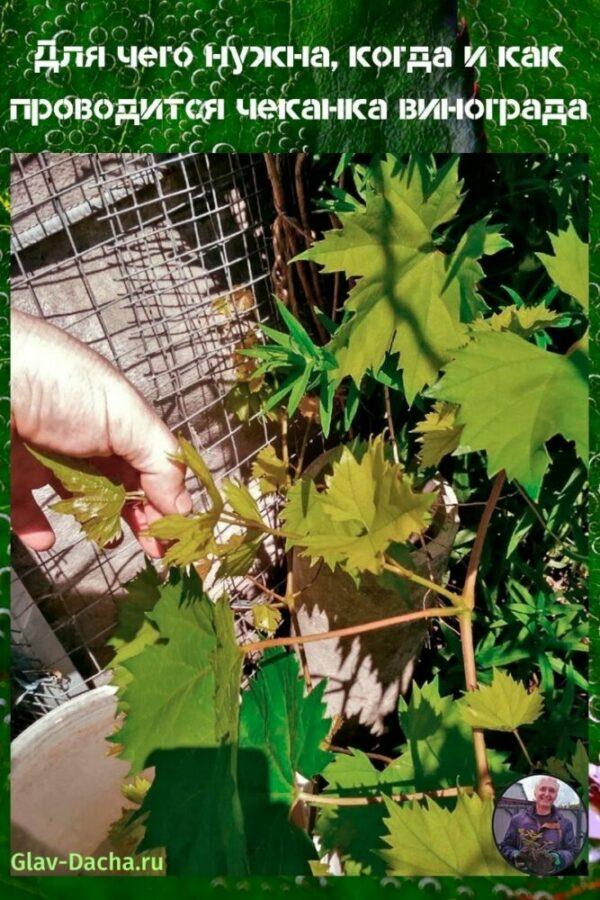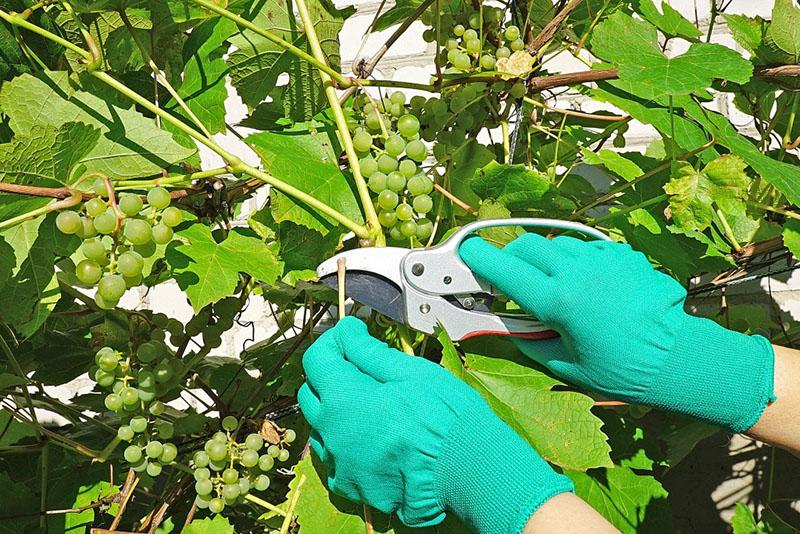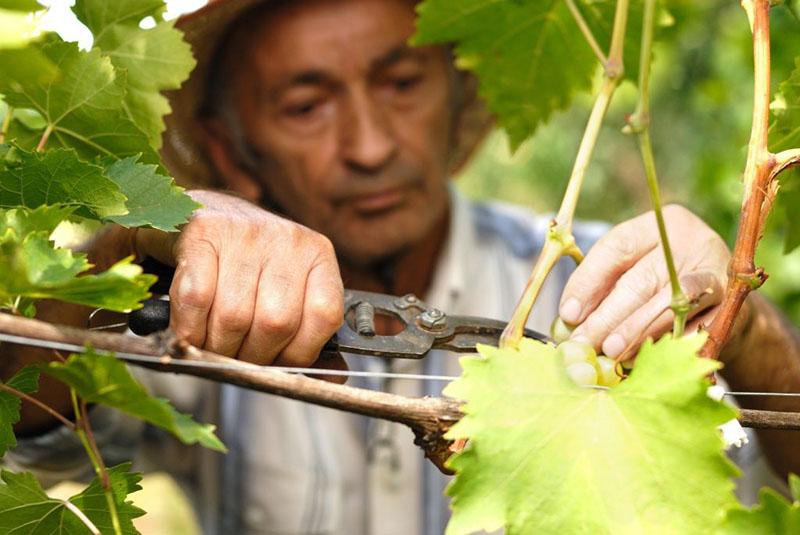What is it for, when and how is the chasing of grapes
 The embossing of grapes is an important step in vine care, which is the pruning of the top of the shoots. A properly performed procedure helps to increase yields, accelerate the growth of the grape bush, and also improve the quality of ripe bunches.
The embossing of grapes is an important step in vine care, which is the pruning of the top of the shoots. A properly performed procedure helps to increase yields, accelerate the growth of the grape bush, and also improve the quality of ripe bunches.
What is grape chasing

Vine shoots are shortened to the first normal leaves. It should be borne in mind that too short a pruning, in which 4-6 leaves are left, cannot fully enrich the grape bunch and saturate it with nutrients. This negatively affects the crop yield.
 After the procedure, 13-16 healthy, fully developed leaves should remain on the shoot.
After the procedure, 13-16 healthy, fully developed leaves should remain on the shoot.
The main goal of minting grapes is to slow down the processes of active growth for 20-30 days, contributing to the redistribution of nutrients between the various organs of the plant.
Chasing grapes - basic rules and benefits
 Before minting grapes, you need to familiarize yourself with the main features and subtleties of the procedure, since mistakes made negatively affect the growth of the vine and yield. The chasing technique is similar to pinching, but in contrast to it, branches are cut much longer, the distant part of the shoot is noticeably larger.
Before minting grapes, you need to familiarize yourself with the main features and subtleties of the procedure, since mistakes made negatively affect the growth of the vine and yield. The chasing technique is similar to pinching, but in contrast to it, branches are cut much longer, the distant part of the shoot is noticeably larger.
To increase the size of the grapes in the bunches, chasing is also carried out - it helps to avoid overloading the plant with a ripe harvest. As a result of this procedure, fruits are formed and ripen on the vine in a timely manner.
During the procedure, shoots that have grown on the central perennial trunk are removed. Also, among what the chasing is made on are branches on fruit arrows and substitute branches.
The main advantages of minting grapes:
- redistribution of nutrients entering the "sleeping" buds and bunches;
- protection of the plant from putrefactive formations and fungal infections;
- full ventilation and uniform lighting of the vine with sunlight;
- accelerated ripening of young shoots;
- preparation of young branches for wintering.
In most cases, minting is carried out on grapes with an average ripening duration. Such varieties are distinguished by their ability to quickly build up green mass. The maximum concentration of nutrients is spent on growing foliage, leading to a slow ripening of bunches, which can stretch until the first frost.
Terms of grape minting
 Before embossing grapes, it is necessary to determine the timing of the procedure. The result obtained depends on this. Pruning is carried out in the phase of suspension of the main growth of the young vine.
Before embossing grapes, it is necessary to determine the timing of the procedure. The result obtained depends on this. Pruning is carried out in the phase of suspension of the main growth of the young vine.
The main sign of slowing growth can be considered the straightening of the upper part of the shoots. With active growth, the shoots begin to bend and tilt downward, since on one side the shoot is stronger and healthier.
The timing of minting depends on the specific grape variety:
- early - from July 15 to August 10;
- mid-season - from 1 to 15 August;
- late - from 10 to 20 August.
If a grape crop is grown in a greenhouse or a greenhouse, it is better to mint it in mid and late July for shoots more than 90-100 cm high and only if necessary.
Subsequent pruning of shoots is carried out in the second half of August and the first week of October. Its purpose is to effectively compact the grape pillar.
Carrying out minting
 Before pruning, you need to consider how the grape shoots are minted. Most experienced gardeners and winegrowers use a pruner.
Before pruning, you need to consider how the grape shoots are minted. Most experienced gardeners and winegrowers use a pruner.
The main stages of pruningand:
- remove the top of each shoot, which has 17-19 true leaves along its entire length;
- the removed section of the shoot should contain up to 5-7 leaves;
- after pruning, pluck the leaves over the top brush in several passes - this will provide a larger size and rich color of the berries.
12-15 days after the minting, the stage of active growth of stepchildren begins. This leads to the accumulation of nutrients and juices necessary for the active development and growth of dormant buds, as well as the formation of inflorescences for the next year.
 If the grapes are minted too early, the stepchildren begin to grow too rapidly and use the entire supply of nutrients until spring. This leads to too early bud break, weakening of the plant and a decrease in the number of fruit ovaries.
If the grapes are minted too early, the stepchildren begin to grow too rapidly and use the entire supply of nutrients until spring. This leads to too early bud break, weakening of the plant and a decrease in the number of fruit ovaries.
When 5-7 mature leaves of the stepson are formed, it is necessary to pinch the stepsons - this will ensure control of their growth. Each should leave 2-4 leaves.
This amount is considered optimal so that the plant can produce and accumulate a sufficient concentration of nutrient juices and keep dormant buds until spring.
Features of the procedure
 In some cases, when minting some vigorous grape varieties, manipulation should be carried out 2-4 times during the growing season. The first manipulation is performed before the beginning of the flowering phase. At this time, up to 10-13 true leaves will be formed on each pruned vine.
In some cases, when minting some vigorous grape varieties, manipulation should be carried out 2-4 times during the growing season. The first manipulation is performed before the beginning of the flowering phase. At this time, up to 10-13 true leaves will be formed on each pruned vine.
Subsequent grape pruning does not affect the shoots, but only the stepchildren, emerging from the upper buds, to a height of 7-8 cm. Such shortening for fast-growing varieties has a positive effect on the ripening of grape bunches. Helps in preparing plant shoots for frost.
Pruned shoots can be used for the benefit of the personal plot - burned, and fertilized with ash fruit and berry bushes and trees. If the branches of the grapes were infected with fungal or other infections, they must be taken out of the garden and burned. This will prevent further spread of the infection.
Contraindications to coinage
 Vine embossing does not always have a positive effect on the growth, development and productivity of a plant. In some cases, this procedure is not recommended.
Vine embossing does not always have a positive effect on the growth, development and productivity of a plant. In some cases, this procedure is not recommended.
Main contraindications:
- Hot, dry summer. Shortening shoots in this case can provoke superficial sunburns of foliage and bunches.
- Wine grape varieties - most often such varieties are small, with a minimum of green mass. Table varieties are more suitable for minting.
- Young vine plantations. The shoots of such a plant are not mature enough for shortening. They may not have enough nutrients for the winter.
- The vine grows on a special arch or gazebo... Such plants do not need to be minted. They already have strong and strong shoots. Evenly illuminated by sunlight and produce a stable harvest.
- The culture is weakened by attacks of insect pests, fungal infections or other diseases.
Chasing grapes is a beneficial procedure that positively affects plant growth, fruit ripening and overall yield. When carrying out it, you need to take into account the main nuances. Among them are the grape variety, the place and characteristics of its growth, as well as the presence of contraindications.